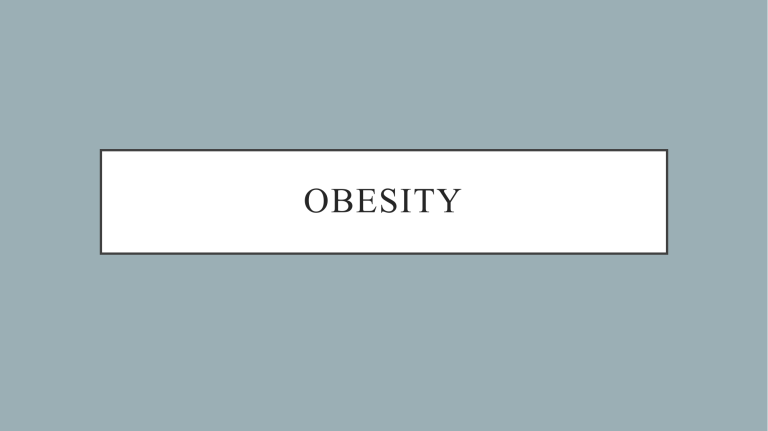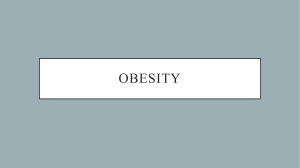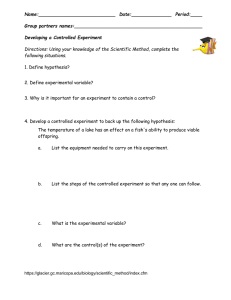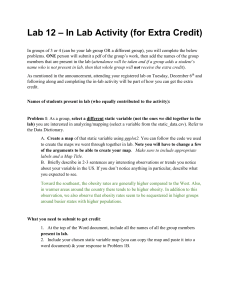
OBESITY INTRODUCTION • The Maricopa Community Coordinated Community Health Needs Assessment reports that obesity percentages range from 28.3% - 29.1% from 2015-2018. • The chronic health problem focused on for this project is obesity among the ages of 1318 years of age. • The County Health Rankings and Roadmaps website reports the percentages of adults with obesity is 27% in Maricopa (85340) (County Health Rankings & Roadmaps). Reference County Health Rankings & Roadmaps. (n.d.). Retrieved September 18, https://www.countyhealthrankings.org/app/arizona/2021/rankin gs/maricopa/county/outcomes/overall/snapshot 2022, from WEB OF CAUSALITY •Access to exercise opportunities - 92% (County Health Rankings & Roadmaps) The accessibility to exercise gives adolescents between the ages of 13-18 a great opportunity to start their fitness regimen early. The earlier one begins to develop healthy habits or love for sports/activities the better chances to continue to engage in these activities in adulthood. •Children eligible for free or reducedprice lunch - 51% (County Health Rankings & Roadmaps). Having access to free or reduced-price lunches at school gives children an opportunity to eat healthier foods. It also indicates that about half of children in school are financially stable to not need additional services for food. Having options to eat healthier food during school can help avoid consuming unhealthy snacks that provide empty calories and have no nutritional value. •Food Insecurity - 17.2 - 22.6% (2019 Maricopa County Community Health Assessment). Food insecurity is harmful to children that require nutrients for healthy development and growth. It can affect their intellectual capacity and deprive them of the energy needed to be active. Obesity Ages 13-18 Maricopa (85340) Legend: Rectangle = Strength Oval = Barriers •Child Abuse - 4.8 - 7.6 children per 1000 (2019 Maricopa County Community Health Assessment). Child abuse and neglect are when a guardian fails to act on behalf of the child. As a result, a child can suffer from physical, emotional, and sexual abuse. This type of neglect can cause trauma that can lead to emotional eating and eating disorders. References County Health Rankings & Roadmaps. (n.d.). Rerieved September 18, 2022, from https://www.countyhealthrankings.org/app/arizona/2021/rankings/maricopa/county/outcomes/overall/snapshot 2019 Maricopa County Community Health Assessment ... (n.d.). Retrieved September 18, 2022, from https://www.maricopa.gov/DocumentCenter/View/ 63108/Maricopa-County-2019-Community-Survey- Report COMMUNITY HEALTH EDUCATION PROJECT Goal: Information related to educating and preventing obesity is provided to all people the ages of 13-18 years of age in Maricopa, AZ within a year. Outline: - Taking a person's height and weight into account, the body mass index is used to measure obesity. - Obesity is primarily caused by the environment around them and the behavior of individuals. Consumption and exercise habits are behaviors. Providing healthy foods, safe activities, and encouraging wellness and health are some ways in which the community can influence behavior. Educational Strategy - Group sharing and presentations. - Presentations require the attention and interest of the audience. - Pedagogy and andragogy models will be used to guide the educational strategy, since learners have different levels of health knowledge. A mixture of Gen Xers and baby boomers may make up this age group. Both have different learning needs. According to Stanhope & Lancaster, 2020, pp. 1459-1460, baby boomers respond better to positive feedback and depend more on the teacher to direct their learning. Gen X adults are independent and focus more on producing good work (Stanhope & Lancaster, 2020, p. 1459-1460). References: Center for Disease Control and Prevention. (2021, January 27). Adult obesity. https://www.cdc.gov/obesity/adult/causes.html Stanhope, M. & Jeanette, L. (2020). Public health nursing: Population-centered health care in the community (10th ed). Elsevier. World Health Organization. (n.d.). Obesity. World Health Organization. https://www.who.int/health-topics/obesity#tab=tab_1 SUMMARY SLIDE Timeline • Planning: 5 months to plan the education and propose the help and expertise from others. This also includes the process of finding a location that is easy to access and have adequate parking for those who may require handicap parking. Towards the end of the date publicizing the event will need to start a month in advance. • Implementation:1 month of education events held, at least one a week for a month in attempt to accommodate people of various schedules and allow word of mouth to spread following the first presentation. This would take place at the start of the new year when people are focused on making changes and after the holidays to allow more attendance. • Evaluation: 4 months to allow the evaluators examine the pre and post-test scores to evaluate their presentation and implementation strategies. Additional time to allow participants to complete surveys regarding their experience and submit a behavioral survey following the presentation. • A strength to increase a successful CHEP • Community collaboration • Decrease a barrier of food insecurity • Accessing to free or reduced-price lunches at school gives children an opportunity to eat healthier foods.



